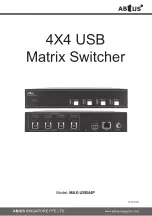
F
F
r
r
e
e
e
e
w
w
a
a
y
y
R
R
a
a
n
n
g
g
e
e
S
S
y
y
s
s
t
t
e
e
m
m
U
U
s
s
e
e
r
r
G
G
u
u
i
i
d
d
e
e
P
P
r
r
o
o
-
-
B
B
e
e
l
l
L
L
t
t
d
d
1
1
8
8
H
H
U
U
-
-
F
F
r
r
e
e
e
e
w
w
a
a
y
y
R
R
a
a
n
n
g
g
e
e
S
S
y
y
s
s
t
t
e
e
m
m
U
U
s
s
e
e
r
r
G
G
u
u
i
i
d
d
e
e
‘
‘
P
P
S
S
U
U
’
’
m
m
o
o
n
n
i
i
t
t
o
o
r
r
p
p
i
i
n
n
o
o
u
u
t
t
s
s
9 way ‘D’ type fixed socket on frame.
Pin
Function
1
CHASSIS
2
PSU 1 RELAY COM
3
PSU 1 RELAY S/C FAIL
4
PSU 1 RELAY O/C FAIL
5
PSU 2 RELAY COM
6
PSU RELAY S/C FAIL
7
PSU RELAY O/C FAIL
8
N/C
9
N/C
S/C - Closed in fail condition
O/C - Open in fail condition
n
n
2
2
.
.
7
7
V
V
i
i
d
d
e
e
o
o
r
r
e
e
f
f
e
e
r
r
e
e
n
n
c
c
e
e
s
s
-
-
B
B
N
N
C
C
s
s
o
o
c
c
k
k
e
e
t
t
s
s
(
(
l
l
o
o
o
o
p
p
i
i
n
n
g
g
)
)
Freeway
can handle video signals of either 525/60 standard or 625/50 standard
(analogue or digital). Some users wish to route both types of signal simultaneously.
Most routers only provide for a single video ‘house reference’ and this presents a
problem because a PAL reference cannot be used to ensure vertical (‘flash-less’)
switching of a 525/60 signal. The converse is also true.
Freeway
delivers maximum
flexibility by providing inputs for both PAL and NTSC ‘house reference’ signals.
Ideally colour-black, the ref signal may also be any stable video signal. Users may
assign which inputs are 525/60, and which are 625/50 via the configuration editor
(described later in this manual).
















































